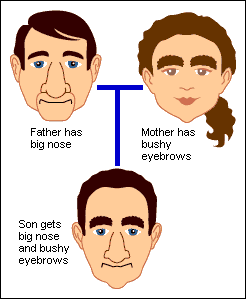 Sex can introduce new gene combinations into a population and is an important source of genetic variation.
Sex can introduce new gene combinations into a population and is an important source of genetic variation.
You probably know from experience that siblings are not genetically identical to their parents or to each other (except, of course, for identical twins). That’s because when organisms reproduce sexually, some genetic “shuffling” occurs, bringing together new combinations of genes. For example, you might have bushy eyebrows and a big nose since your mom had genes associated with bushy eyebrows and your dad had genes associated with a big nose. These combinations can be good, bad, or neutral. If your spouse is wild about the bushy eyebrows/big nose combination, you were lucky and hit on a winning combination!
This shuffling is important for evolution because it can introduce new combinations of genes every generation. For example, in a particular population, plants with reddish flowers and plants with longer more tubular flowers might each do fine on their own – but if sex and genetic shuffling produced a plant with both traits (red tubular flowers), the combination might attract a new pollinator (hummingbirds) and alter the evolutionary trajectory of the lineage. Of course, sex and genetic shuffling can also break up good combinations of genes and form bad ones.
Read more about the recombination of genes in reproduction.
Learn more about recombination in context:
- Evolution in the fast lane?, a news brief with discussion questions.
- Why the Y is here to stay, a news brief with discussion questions.
Reviewed and updated June, 2020.
